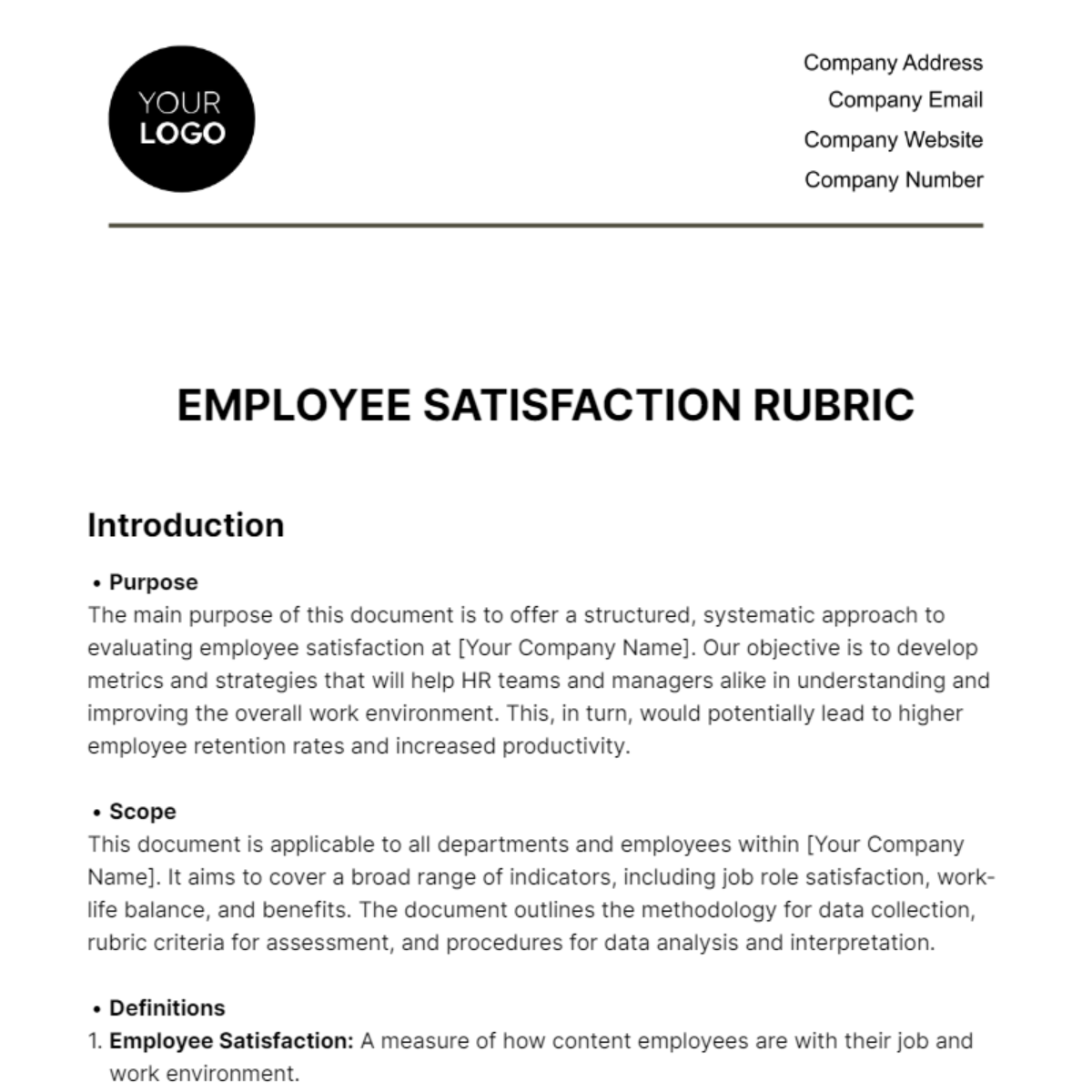Free Employee Satisfaction Rubric HR

Introduction
Purpose
The main purpose of this document is to offer a structured, systematic approach to evaluating employee satisfaction at [Your Company Name]. Our objective is to develop metrics and strategies that will help HR teams and managers alike in understanding and improving the overall work environment. This, in turn, would potentially lead to higher employee retention rates and increased productivity.
Scope
This document is applicable to all departments and employees within [Your Company Name]. It aims to cover a broad range of indicators, including job role satisfaction, work-life balance, and benefits. The document outlines the methodology for data collection, rubric criteria for assessment, and procedures for data analysis and interpretation.
Definitions
Employee Satisfaction: A measure of how content employees are with their job and work environment.
Rubric: A set of criteria used to evaluate a particular set of activities or tasks.
Metric: A method of measurement that employs numerical data to assess performance or satisfaction.
Satisfaction Metrics
Job Satisfaction
This metric assesses the level of happiness and fulfillment employees experience in their job roles. Questions will be focused on job responsibilities, career growth, and alignment with company values. Job satisfaction is crucial for employee engagement and retention.
Work-Life Balance
This metric evaluates the balance employees maintain between work responsibilities and personal life. Criteria will include flexible working hours, workload, and the ability to take time off for personal needs. A positive work-life balance enhances employee well-being.
Benefits & Compensation
This involves evaluating the remuneration and benefits package offered by [Your Company Name]. It will include elements like salary, health benefits, and retirement plans. Employee satisfaction often correlates with the perceived value of their compensation.
Professional Development
This metric looks at training and development opportunities provided by the company. Criteria will include available training programs, mentorship opportunities, and career development paths. This metric is essential for skill development and career progression.
Team & Management
This measures the level of comfort and cooperation among team members and between employees and management. The criteria will consider team dynamics, leadership effectiveness, and conflict resolution methods.
Data Collection Methods
Surveys
Employee surveys will be the primary method of data collection. These will be disseminated via [Your Company Email] and are expected to take no more than 20 minutes to complete.
Interviews
Personal interviews will be held with selected employees to acquire more nuanced insights. The interview process will be standardized to ensure unbiased data collection.
Focus Groups
Focus groups of 5-7 employees will discuss various topics related to workplace satisfaction. A trained moderator will guide the discussion, and sessions will be recorded for analysis.
Rubric Criteria
Grading Scale
The grading scale will range from 1 to 10, with 10 being the highest level of satisfaction. The interpretation of these scores is outlined in the following table:
Score | Interpretation |
1-2 | Highly Dissatisfied |
3-4 | Dissatisfied |
5-6 | Neutral |
7-8 | Satisfied |
9-10 | Highly Satisfied |
Category Weights
Each satisfaction metric has been assigned a specific weight to reflect its importance in the overall employee satisfaction index. The weights are as follows:
Metric | Weight (%) |
|---|---|
Job Satisfaction | 30 |
Work-Life Balance | 25 |
Benefits & Compensation | 20 |
Professional Development | 15 |
Team & Management | 10 |
Data Analysis
Data Collection
Data will be collected using secure forms and stored in encrypted databases. Only authorized personnel within the HR department at [Your Company Name] will have access to this data.
Data Processing
Data will be analyzed using statistical software to generate insights. These insights will be used to improve various aspects of employee satisfaction, such as benefits packages and work-life balance policies.
Sample Charts & Diagrams
Charts and diagrams will be generated post-data collection to visually represent the insights obtained. This will make the data easier to interpret and share with relevant stakeholders.
Conclusion
Summary
The Employee Satisfaction Rubric provides a comprehensive framework for evaluating and improving employee satisfaction at [Your Company Name]. It is designed to be adaptable and scalable to meet the unique needs of different departments and teams.
Recommendations
Post-analysis, specific recommendations will be made to target areas in need of improvement. These could range from revamping the benefits package to implementing new training programs.
Appendix
Sample Survey Questions
This section will include a set of sample questions that can be incorporated into the employee satisfaction survey.
Reference Documents
This section will list any external reports, articles, or data sets that have been referred to during the development of this rubric.
Contact Information
For any further questions, clarifications, or recommendations, please feel free to reach out to the following contact points:
Name: [Your Name]
Email: [Your Email]
Contact Number: [Your Company Number]
Office Address: [Your Company Address]
For more information, you can also visit our website: [Your Company Website]
- 100% Customizable, free editor
- Access 1 Million+ Templates, photo’s & graphics
- Download or share as a template
- Click and replace photos, graphics, text, backgrounds
- Resize, crop, AI write & more
- Access advanced editor
Measure and enhance employee satisfaction with our Employee Satisfaction Rubric HR Template. This tool provides a structured format for assessing employee satisfaction through various criteria, ensuring a comprehensive evaluation. It's an invaluable resource for HR professionals aiming to improve workplace morale and retention. Secure your copy today and gain deeper insights into your employees' satisfaction levels.
You may also like
- Employee Letter
- Employee ID Card
- Employee Checklist
- Employee Certificate
- Employee Report
- Employee Training Checklist
- Employee Agreement
- Employee Contract
- Employee Training Plan
- Employee Incident Report
- Employee Survey
- Employee of the Month Certificate
- Employee Development Plan
- Employee Action Plan
- Employee Roadmap
- Employee Poster
- Employee Form
- Employee Engagement Survey





























